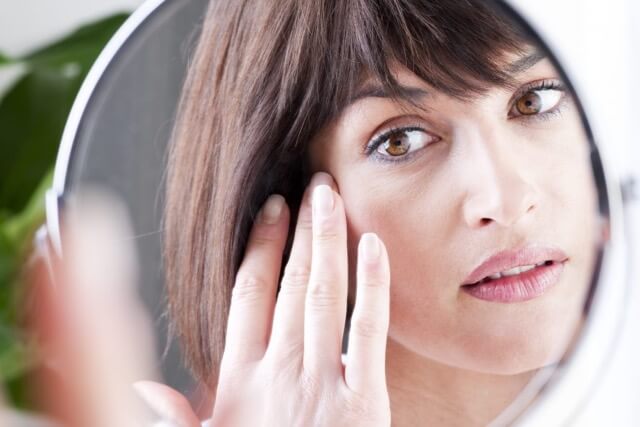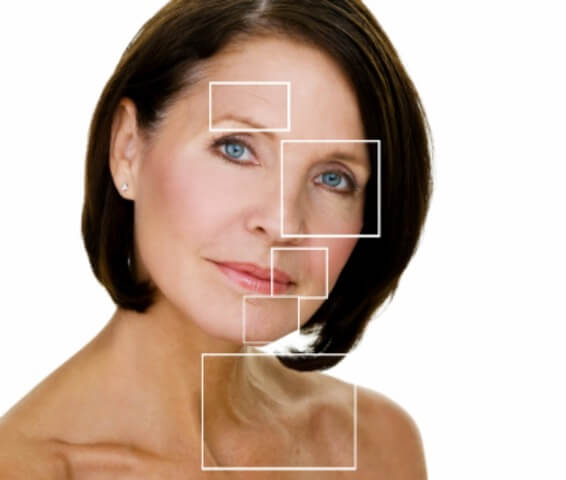Perimenopause is the time before your last period. It typical starts from mid-40’s but for some can be as early as 35. Symptoms eg low energy, mood swings, PMS, low confidence, low libido and change in your periods can all be the norm. For some it can be mild but for others, it’s like navigating through turbulent seas.
This is due to ovaries slowing down in releasing eggs so hormones don’t follow the predictable monthly pattern and fluctuate (sometimes wildly). During this time, women not only FEEL a difference in themselves but can also SEE a difference in their skin.
In this blog post, I will share common skin concerns I see in clinic due to perimenopause and share some tips on how to improve it.
Perimenopause general comes in 2 phases:-
Phase 1 – Progesterone starts to drop first.
This is a skin and mood calmer, helping you sleep better and control cravings. When progesterone is low, I find skin gets oilier, it breaks out, becomes more sensitive and flushed. Oestrogen then becomes relatively more in the equilibrium, resulting in water retention, puffiness and increased pigmentation.
Phase 2 – this occurs in later years when Oestrogen starts to fall too.
Oestrogen keeps us sharp, feminine, calm and on the ball. It also protects our bones, heart, gut and brain. For the skin, it controls skin hydration and collagen production. When oestrogen falls, you may find more visible wrinkles and broken veins, drier and skin losing it’s firmness, elasticity and glow. Fat distribution changes – it depletes in some areas (eg the eyes) and expand in others (eg the jowls). Bone density reduces so the facial bones becomes flatter and shorter, creating an ageing look.
There are also other hormones involved:-
- testosterone drops which reduces muscle tone and skin firmness
- cortisol increases which increases inflammation
- thyroid becomes sluggish which causes dry skin
Growing older might sound scary but my aim is to educate you on what goes on with your hormones and skin so you can choose how to improve it or change it if you wish to.
So let’s dive a little deeper into the 2 most common skin concerns I see in clinic.
How to improve Hormonal Acne due to Perimenopause

As mentioned above, one of the changes seen is acne due to a drop in progesterone which is a skin and mood calmer. Below, I’ve shared important lifestyle tips and recommend herbs/supplements that can help. Please take note, if you have medical issues, on medication or unsure if any of the suggestions is right for you below, please seek professional advice before starting a new regimen.
- Remove sources of stress or manage your stress because stress depletes progesterone even more through a process called “cortisol steal”
- Minimise or avoid caffeine because this increases the stress response and forces your body to excrete important minerals required for healthy hormone production
- Get good quantity and quality of sleep (if you only do this, it will make a HUGE difference)
- Eat more foods rich in Vitamin C, B6, Magnesium and Zinc which are important for the production of progesterone, skin repair and reducing inflammation. These include spinach, leafy greens, walnuts, lean red meat (for zinc), seafood, fish, beans, pumpkin seeds, bananas, dark chocolate, watermelon + chick peas
- Take a multivitamin + multimineral supplement especially if you live a hectic or stressful lifestyle or know you’re not getting enough nutrients from your food. I usually recommend taking an extra Vitamin C 750mg/day
- Take Epsom salt baths (2 cups in a bath 2-3x a week) or use a magnesium oil spray every day to boost your magnesium levels. Magnesium can help improve PMS, calm nerves and improve sleep
- Take Omega 3 which is shown to reduce cortisol (minimum 1000mg/ day. Increase to 2000mg/day if you live a hectic lifestyle)
- Take Vitex (Agnus Castus) or chasteberry which helps relieve PMS
- Consider a DIM supplement – this is mainly to counteract the effects of relatively high Oestrogen (due to low progesterone)
How to improve wrinkles, dry and lax skin in Perimenopause

This is seen more often in Phase 2 where Oestrogen starts to drop a lot more and your skin gets drier and more sensitive; broken veins and wrinkles become more visible; the skin becomes less elastic and firm.
The focus will be to boost hydration and collagen production.
- Remove/reduce or manage stress because high cortisol breaks down collagen quicker
- Sleep well, long + often enough because the skin repairs while you sleep. Good quality sleep = good quality repair
- Eat Healthy fats eg avocado, chick peas, nuts, oily fish, olive oil, pasteurised chicken eggs, butter from grass fed cows + coconut. This will help maintain skin hydration and strengthen skin cell walls
- Take an Omega 3 at least 2000mg/day as it reduces inflammation and supports point 3 above
- Boost Vitamin C (as it helps produce collagen + maintain skin’s elasticity), Vitamin E (as it hydrates the skin + prevents cell damage), Vitamin D as it increases immunity and protects the skin and Vitamin A (as it helps produce collagen and reduce signs of ageing)
- Eat enough protein as you need it as building blocks to make collagen eg chicken, eggs, lean meats, beans, quinoa + low mercury fish. Aim for 70-90g of protein a day, even more if you’re exercise regularly
- Maintain copper – an essential element for optimal collagen formation. The recommended daily allowance is 2mg/day. Foods rich in copper are liver (eg 1 TBS of pate = 0.5mg), oysters (1 wild caught = 0.5mg) + sesame seeds (1 TBS= 0.4mg)
- Take a collagen supplement or make your own healthy bone gelatin broth. There are collagen powders, capsules + liquids. Aim for at least 5g/ day. Go up to 10g/day if you’re exercising regularly or if you’re due to have collagen skin boosting treatments
- Body/Bio-identical HRT which can definitely help as it replaces the hormones depleted
There’s a lot more I could write on the topic but I hope this blog helps get you on a good start to improving your skin during Perimenopause.
If you have any specific questions, you can find me on social media or email on [email protected].
If you need help creating a skin plan for your changing skin during this season of your life, you can find more information here.
If you are anything like me and like to know why things happen, I recommend doing a DUTCH test (dried urine test for comprehensive hormones). It not only tells you your hormone levels but also look at how it’s being made and broken down into. This information is helpful in knowing whether you are balanced or not, plus whether the metabolites that it’s broken down into is healthy or damaging to your health. Please email [email protected] for more information.
Until then, here’s to beautiful skin now and in the future.
Warmest regards,
Dr Terry

